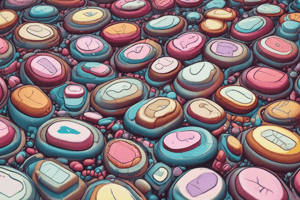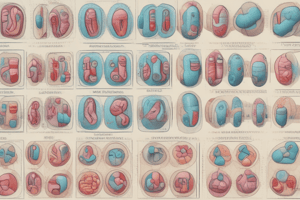Podcast
Questions and Answers
What is the primary function of antibiotics?
What is the primary function of antibiotics?
- To reduce inflammation
- To prevent and treat bacterial infections (correct)
- To lower blood pressure
- To treat viral infections
Which mechanism of action involves weakening the bacterial cell wall?
Which mechanism of action involves weakening the bacterial cell wall?
- Interference with DNA replication
- Inhibition of metabolic pathways
- Inhibition of protein synthesis
- Inhibition of cell wall synthesis (correct)
What type of antibiotic is effective against a wide range of bacteria?
What type of antibiotic is effective against a wide range of bacteria?
- Narrow-spectrum
- Limited-spectrum
- Specific-spectrum
- Broad-spectrum (correct)
Which class of antibiotics inhibits cell wall synthesis?
Which class of antibiotics inhibits cell wall synthesis?
What is one way bacteria can develop resistance to antibiotics?
What is one way bacteria can develop resistance to antibiotics?
Which of the following contributes to antibiotic resistance?
Which of the following contributes to antibiotic resistance?
What is a consequence of antibiotic resistance?
What is a consequence of antibiotic resistance?
Which strategy can help combat antibiotic resistance?
Which strategy can help combat antibiotic resistance?
What is a common adverse effect of antibiotics?
What is a common adverse effect of antibiotics?
What is the most common route of administration for antibiotics in mild to moderate infections?
What is the most common route of administration for antibiotics in mild to moderate infections?
Flashcards
Antibiotics
Antibiotics
Medications used to prevent and treat bacterial infections by killing bacteria or preventing their growth.
Antibiotic Mechanism of Action
Antibiotic Mechanism of Action
Antibiotics target essential bacterial processes to inhibit growth or kill the bacteria.
Broad-spectrum antibiotics
Broad-spectrum antibiotics
Effective against a wide range of bacteria, including both Gram-positive and Gram-negative types.
Antibiotic Resistance
Antibiotic Resistance
Signup and view all the flashcards
Mechanisms of Antibiotic Resistance
Mechanisms of Antibiotic Resistance
Signup and view all the flashcards
Factors Contributing to Antibiotic Resistance
Factors Contributing to Antibiotic Resistance
Signup and view all the flashcards
Strategies to Combat Antibiotic Resistance
Strategies to Combat Antibiotic Resistance
Signup and view all the flashcards
Antibiotic Allergic Reactions
Antibiotic Allergic Reactions
Signup and view all the flashcards
Common Gastrointestinal Disturbances
Common Gastrointestinal Disturbances
Signup and view all the flashcards
Antibiotic Administration Routes
Antibiotic Administration Routes
Signup and view all the flashcards
Study Notes
- Antibiotics are medications used to prevent and treat bacterial infections.
- They work by killing bacteria or preventing their growth.
Mechanism of Action
- Antibiotics target essential bacterial processes to inhibit growth or kill the bacteria
- Inhibition of cell wall synthesis is a common mechanism, weakening the bacterial cell wall and leading to lysis.
- Some antibiotics inhibit protein synthesis by binding to bacterial ribosomes, disrupting the production of essential proteins.
- Certain antibiotics interfere with DNA replication or transcription, preventing the bacteria from multiplying.
- Inhibition of metabolic pathways is another mechanism where antibiotics disrupt essential biochemical reactions in bacteria.
Spectrum of Activity
- Antibiotics are classified based on their spectrum of activity: narrow-spectrum or broad-spectrum.
- Narrow-spectrum antibiotics are effective against a limited range of bacteria.
- Broad-spectrum antibiotics are effective against a wide range of bacteria, including both Gram-positive and Gram-negative bacteria.
- Using broad-spectrum antibiotics can lead to the disruption of the normal microbiota and increase the risk of antibiotic resistance.
Classes of Antibiotics
- Penicillins are a class of beta-lactam antibiotics that inhibit cell wall synthesis.
- Cephalosporins are another class of beta-lactam antibiotics with a similar mechanism of action to penicillins.
- Macrolides inhibit bacterial protein synthesis by binding to the 50S ribosomal subunit.
- Tetracyclines also inhibit protein synthesis but bind to the 30S ribosomal subunit.
- Fluoroquinolones inhibit bacterial DNA replication.
- Aminoglycosides inhibit protein synthesis and disrupt the bacterial cell membrane.
Antibiotic Resistance
- Antibiotic resistance occurs when bacteria evolve mechanisms to survive exposure to antibiotics that would normally kill them or stop their growth.
- Resistance can develop through several mechanisms, including enzymatic inactivation of the antibiotic.
- Bacteria can modify the target site of the antibiotic, preventing it from binding effectively.
- Reduced permeability of the bacterial cell membrane can prevent the antibiotic from entering the cell.
- Bacteria can actively pump the antibiotic out of the cell using efflux pumps.
- Horizontal gene transfer, such as conjugation, transduction, and transformation, facilitates the spread of resistance genes between bacteria.
Factors Contributing to Antibiotic Resistance
- Overuse and misuse of antibiotics in human medicine and agriculture are major drivers of antibiotic resistance.
- Inappropriate prescribing of antibiotics for viral infections contributes to resistance.
- Patients not completing the full course of antibiotics allows more resistant bacteria to survive.
- The use of antibiotics in animal feed promotes the development of resistance in animal bacteria, which can then spread to humans.
- Poor hygiene and sanitation practices facilitate the spread of resistant bacteria.
- International travel and trade contribute to the global spread of antibiotic resistance.
- Lack of development of new antibiotics exacerbate the problem.
Consequences of Antibiotic Resistance
- Antibiotic-resistant infections are more difficult and expensive to treat.
- Increased morbidity and mortality are associated with resistant infections.
- Longer hospital stays and increased healthcare costs are common outcomes.
- The need for more toxic and expensive alternative antibiotics may arise.
- Spread of resistant bacteria can lead to outbreaks.
Strategies to Combat Antibiotic Resistance
- Improving antibiotic prescribing practices by using diagnostic tests to confirm bacterial infections.
- Implementing antibiotic stewardship programs in healthcare settings to promote appropriate antibiotic use is important.
- Educating the public about the appropriate use of antibiotics reduces unnecessary demand.
- Enhancing infection prevention and control measures limits the spread of resistant bacteria.
- Promoting the development of new antibiotics and alternative therapies addresses the lack of effective treatments.
- Strengthening surveillance of antibiotic resistance to track trends and identify emerging threats is needed.
- Reducing the use of antibiotics in agriculture through regulations reduces pressure for resistance development.
- Improving sanitation and hygiene practices worldwide reduces the transmission of bacteria.
- Ensuring access to vaccines helps prevent bacterial infections, reducing the need for antibiotics.
Adverse Effects
- Antibiotics can cause a variety of adverse effects, including:
- Allergic reactions, ranging from mild skin rashes to severe anaphylaxis, can occur.
- Gastrointestinal disturbances such as nausea, vomiting, and diarrhea are common.
- Disruption of the normal gut microbiota can lead to Clostridium difficile infection.
- Some antibiotics can cause organ-specific toxicities, such as nephrotoxicity or ototoxicity
- Photosensitivity, where the skin becomes more sensitive to sunlight, can occur with certain antibiotics
Administration
- Antibiotics can be administered through various routes:
- Oral administration is the most common route for mild to moderate infections.
- Intravenous administration is used for severe infections or when oral administration is not possible.
- Intramuscular administration is another option for certain antibiotics.
- Topical antibiotics are used for skin infections.
Studying That Suits You
Use AI to generate personalized quizzes and flashcards to suit your learning preferences.
Description
Explore antibiotics and their role in preventing and treating bacterial infections. Learn about their mechanisms of action, including cell wall synthesis inhibition and protein synthesis disruption. Understand the difference between narrow-spectrum and broad-spectrum antibiotics.




